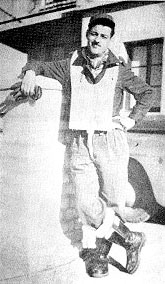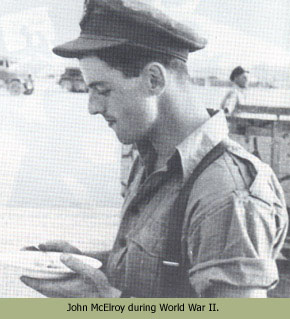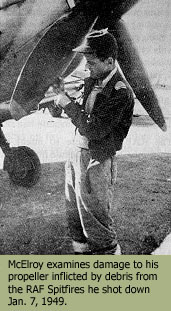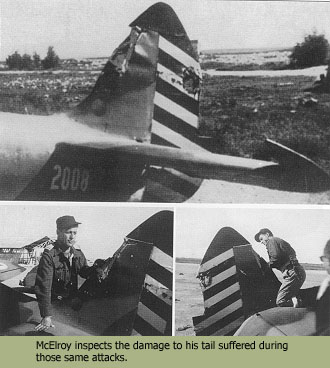 John McElroy
John McElroy John McElroy
John McElroy
Port Arthur, Ontario
Combat Record
WWII: Ten kills (and one probable), four shared kills, and 12 enemy aircraft damaged while flying the Spitfire Vc (in Malta) and IXb (in England).
December 30: MC.205V (in unidentified Spitfire)
January 7: Two RAF Spitfire FR 18s (in Spitfire White 15)
Story
McElroy's military career began in the Canadian infantry. He served with the North Battleford Light Infantry and in the Rocky Mountain Rangers before enlisting in the RCAF in 1940. He was commissioned in September 1941, left for the UK in November, and joined 54 Squadron at the start of April 1942.
 In spring 1942, McElroy
was posted to Malta. He made an inauspicious debut. On June 9, while taking
off in a Spitfire Vc from the HMS Eagle to reinforce that island as part of
Operation Salient, McElroy damaged the aircraft's tail. He crashed on landing,
and the wing commander grounded him temporarily. George Beurling made the HMS
Eagle-Malta flight the same day and both joined 249 Squadron.
In spring 1942, McElroy
was posted to Malta. He made an inauspicious debut. On June 9, while taking
off in a Spitfire Vc from the HMS Eagle to reinforce that island as part of
Operation Salient, McElroy damaged the aircraft's tail. He crashed on landing,
and the wing commander grounded him temporarily. George Beurling made the HMS
Eagle-Malta flight the same day and both joined 249 Squadron.
Within a month, McElroy had racked up two kills, a shared kill and a damaged enemy. On October 19, for his seven kills, one probable kill, two shared victories, and ten more enemy aircraft damaged, McElroy received the DFC and promotion to Flight Leader. Included his initial flight to Malta, he had crash-landed three times - once after suffering a slight leg wound - and landed a severely damaged Spitfire another time.
McElroy shot up two more enemy fighters before the end of October, and left Malta by the end of the year to become an instructor and take leave in Canada.
He returned to combat in January 1944 with Canada's 421 Squadron. After damaging a Me 109 on 15 June, he took some hits himself over Caen, but he managed to crash behind friendly lines. He'd score another two kills before receiving a promotion to Squadron Leader and command of 416 Squadron, another Canadian unit. He tacked on another kill, another damaged, and a Bar to his DFC before leaving Europe in October, 1944.
McElroy returned to Canada, spending the rest of his service on the Pacific coast. Upon his release from service on September 24, 1945, McElroy joined the Auxiliary Air Force, flying with 442 Squadron as an instructor. Obviously, he loved to fly.
May, 1948 found McElroy still out west, living in Vancouver. Two Jewish acquaintances asked for his help in finding pilots to fly for Israel. McElroy agreed to help recruit pilots and contacted more than 40 flyers, some of whom agreed to go. Len Fitchett, who would later be killed along with Stan Andrews after crashing his Beaufighter, was one of McElroy's contacts.
After the police visited McElroy's wife to ask about his activities, McElroy decided to leave Canada for a while and left for Israel to do a little flying himself. McElroy met two other volunteers from Canada, Denny Wilson and Jack Doyle, on the way. Wilson comments:
I was given a ticket to Toronto, stayed in Toronto for about two weeks then was given a ticket to Geneva, by way of London. Met Jack Doyle and John McElroy. All three of us went from Geneva to Rome, where we waited for another week, then on a South African Airways aircraft to Haifa. (Cull et al 1994)
Wayne Peake was on the same flight into Haifa. According to Denny Wilson, when Israeli authorities first questioned McElroy as to why he was in Israel, the pilot responded, "I came to fly your fucking airplanes." (Rubenstein and Goldman 1978)
McElroy found the 101 funny. He thought that a single squadron operating the mix of aircraft types that the 101 did was "the funniest thing I ever seen anywhere in flying." (Rubenstein and Goldman 1978)
He recalls listening in on a briefing in October, detailing an escort mission of 69 Squadron's B-17s:
The fighter escort from 101 Squadron took off and they had two Spitfires and two P-51s and two Messerschmitts. This represented three air forces.... It was the entire strength of 101 Squadron at the time and the funniest part was... they decided because the Messerschmitt was the most dangerous airplane to fly and the Spit was the most valuable, they'd get the two Spitfires off first and then they'd send off the two P-51s and let the 109s get off the ground last. And it was the same when they got back. The landing was the same procedure. The Spitfires landed first, and then the Mustangs. I thought it was quite humorous. (Rubenstein and Goldman 1978)
Ferry pilots for Velvetta 2, drawn primarily from 101 Squadron, landed in Prague on December 9.
After a delay caused by winter storms, Velvetta 2 began as six Spitfires left Czechoslovakia at 10:00 on Dec. 18. Sam Pomerance (in Spitfire 2006 or 2007) took first to lead Caesar Dangott and Bill Pomerantz (2007 or 2006) while George Lichter led John McElroy and Moti Fein (later Moti Hod), an air cadet. In the low visibility conditions, Bill Pomerantz quickly lost the others. With the cloud cover still solid at 14,000 feet, after an hour and a half, Lichter decided to return to Kunovice with the others, but Pomerance, who along with Lichter had the only airborne radios, told Lichter he'd press ahead.
Pomerance died when he crashed into a mountain in Yugoslavia.
Pomerantz ditched in Yugoslavia and although his aircraft burned up, he suffered only minor injuries. McElroy, a veteran of Spitfire ferry operations into Malta, in anger over the failure refused to follow a less experienced pilot a second time and was give a flight of three to lead the next day, when George Lichter led Shapira and Fein with John McElroy leading Caesar Dangott and Arnold Ruch along the assigned route. (You can find plane assignments in Cull et al 1994 but I question its accuracy on this point.). Clouds still blanketed the terrain. Danny Shapira, a cadet flying in the group, said, "McElroy was so close to Lichter that, when he closed the formation in the clouds, I could see his propeller underneath the tail of Lichter's Spitfire." (Cull et al 1994) Despite a bout of disorientation on Shapira's part and a minor fuel leak in Fein's plane, all made the three-hour, forty-minute flight safely.
McElroy elected not to fly the Niksic-Israel leg of the journey - some reports say he got the shakes. He probably hitched a ride back on one of the C-46s that took the two unrepairable airframes and spare parts across the Mediterranean on December 28.
Action came quickly after Velvetta 2. On December 30, McElroy and wingman Jack Doyle (in White 24) each shot down a MC.205V that had been strafing Israeli troops near the REAF Bir Hama air base, killing the two Egyptian pilots, S/L Mustafa Kamal Abd al Wahib and F/L Kahlil Jamal al Din al Arusi. Doyle explains:
Johnny McElroy and I were doing a recce of Bir Hama when I saw two enemy aircraft strafing our troops. I cut into their circuit and shot down the leader. The second one broke and ran with Johnny on his tail. In a short while he finished him off and we returned to base. (Cull et al 1994)
On January 7, McElroy and Slick Goodlin took part in what is probably the most memorable air combat of the war.
On January 7, we had done a couple of patrols and we had been told that there was going to be a truce effective at 4:00 p.m. I was sitting in the dispersal hut down on the field at Qastina (Chatzor) with Slick Goodlin and Lee Sinclair. It was late in the afternoon; I think it was probably around 2:15 or 2:30. And I said to Slick, 'I got a funny feeling there's a patrol in the area now down around the El Arish-Auja area. Let's see if we can get a couple of airplanes and take off down there for one more patrol.'
Well, Slick said he'd go along and Lee said he wanted to go, so I went to the Engineering Officer and asked if he had two Spitfires ready to go and he said there's maybe (also) a P-51. I said, 'Fine. Slick and I will fly the Spitfires and Lee will take the P-51 and act as sort of a top cover for us and we'll go down and see what we can find.'
Slick, though an American, didn't take the P-51 because during that period he had indicated a preference for the Spit for combat work. He thought it was easier to handle and more maneuverable. Slick liked the 20mm cannon which we had in our Spits: more effective firepower. The Spitfire had two 20mm cannon and two .50-inch machine guns, the standard American weapon.
I showed the boys the area on the map where we'd go and what area we'd look for. The Engineering Officer came in and said that the P-51 was not serviceable. He had thought it was, but it wasn't. So Lee Sinclair couldn't go. Slick and I went by ourselves.
The two of us went down there, down the coast. We were flying at 16,000-18,000 feet. We didn't say much. We were trying to observe radio silence. I didn't know what effect it would have, but we didn't want too many people to know we were coming. (Rubenstein and Goldman 1978)
Despite the loss of its recon Mosquito on Nov. 20, the RAF continued to keep an eye on the war. The British had every right to overfly the Sinai, which belonged to Egypt proper, but by the closing stages of the war much of the northeastern Sinai lay in Israeli hands. On the morning of Jan. 7, the RAF sent two reconnaissance missions from its bases in the Suez Canal Zone to the battlefield. A Mosquito PR 13 from 13 Sqn at RAF Kabrit accompanied by four Tempest F 6s from RAF Deversoir had an uneventful sortie. Four Spitfire FR 18s from 208 Squadron - formerly based at RAF Ramat David - left RAF Fayid at 11:15 and had a radically different experience. F/O Geoff Cooper led F/O Tim McElhaw and their wingmen, P/2 Frank Close and P/2 Ron Sayers respectively, to survey the Israeli-held land around Nitzana and Rafah and to determine the whereabouts of the REAF Spitfire the Israelis had captured on December 29. Another 208 Sqn pilot had photographed the Spitfire being towed while on a recon flight on Jan. 1.
The RAF patrol was ordered to fly to Abu Ageila and separate into two sections. Cooper and Close were to fly at 500 feet with the other two covering them at 1,500 feet. After separating, the four were to fly east to the Negev-Sinai border, which they would then follow north to Rafah. As they flew their designated patrol, the Mosquito and four Tempests observed four REAF 2 Sqn Spitfires (Macchis according to Huertas 1998) attack an Israeli column near Rafah, destroying three trucks.
The first RAF patrol and Egyptians had left the scene by the time the 208 Sqn Spitfires appeared, a quarter-hour after the Egyptian attack. The 208 Sqn pilots spotted smoke rising over a thousand feet into the air, the result of the Egyptian attack, and flew in for a closer look with Cooper and Close passing low over the Israelis.
McElroy (in White 15) and Goodlin (in White 16 or 23) had been flying for a while before McElroy spotted the same smoke:
It was pretty uneventful for the first 20 to 25 minutes of the flight. And then, all of a sudden, I said to Slick - he was on my left wing - I said, "Look at that smoke over here to the left, on the ground." It seemed to be about eight or ten miles away.
We were a good 40 to 50 miles south of Faluja. It was right on the front line. And there were three columns of smoke - pretty heavy black smoke - going up about 1,000 feet. So I said, "Come on. We'll turn and have a look at this." And as we got closer, I said, "My God!" We could see trucks burning. We could see a couple of light armored vehicles and a number of jeeps. We saw no airplanes at that time. (Rubenstein and Goldman 1978)
They identified the column as Israeli and looked around for enemy aircraft. Chatter on the radio from the ground forces alerted them to the presence of unseen enemy aircraft. The two groups of Spitfires had arrived more or less simultaneously.
McElroy spotted four aircraft flying low over the vehicles - in fact, he thought they were strafing the column:
There were no markings on the Spitfires. Two of them were headed in an easterly direction. And there were two that had gotten out of sight in a dive. They were diving and we lost them. So I warned Slick to watch out and we got over the convoy. (Rubenstein and Goldman 1978)
The two diving Spitfires must have been Cooper and Close going in for a closer look and photos. The covering pair of McElhaw and Sayers had spotted the Israeli Spitfires, but not in time. They warned the lower pair of the presence of "bogies at three o'clock" just as the Israeli gunners on the ground opened fire. It's possible the lower pair of RAF Spitfires didn't see the Israeli aircraft among the scattered cloud, blowing sand, and smoke.
Close later recalled:
Our leader took photographs and there was some small arms fire from the ground. The leader (Cooper) was flying at 500 feet. I was his Number Two and was flying right on the deck, because it was safer from ground fire. I assume it was then that the odd bullet got my engine. I pulled up and the plane caught fire immediately and I jumped. (Cull et al 1994)
The Israelis on the ground shot at the incoming RAF Spitfires and hit Close's engine. He bailed out at 500 feet, suffering a mild concussion and a broken jaw when his head hit the tail of his aircraft (or possibly after his feet became entangled in the chute rigging and he hit his head on landing). Cooper, hit less critically, climbed steeply to get out of range of the gunners.
McElhaw and Sayers, and Cooper apart from them, watched Close's chute as he descended.
At that point, McElroy spotted two Spitfires pair dead ahead and low. Oddly, these two appear to have been Cooper and Sayers. Sayers's wingman, McElhaw, escaped this first attack. McElroy narrates:
Slick was right beside my wing. He'd crossed over on the starboard side and I pulled another turn and turned south to see if we could pick up the other airplanes. Slick moved over to my left. And just as he did, I yelled, "There's an enemy aircraft at twelve o'clock, right in front if us!" They were about 3,000 feet lower than us. So we stuck our noses down and Slick moved off to the left and started firing. We were right on top of them. They pulled up right in front of us and I blasted one, I guess from about 200 yards, and I saw many explosions all around. Engine. Cockpit. I knocked quite a few pieces off his wings.
They'd just pulled out of this dive. They didn't see us at all. They didn't know we were even in the area. I broke off, looked at Slick. He had disappeared from view, but I saw an airplane going down off my left. It was on fire and smoking, in a fairly steep dive around to the left. (Rubenstein and Goldman 1978)
The RAF aircraft McElroy hit dove straight down into the sand dunes, Sayers still inside. (Note that Huertas 1998 has a different description of who shot whom and when.)
Cooper, Goodlin's target, had headed higher hoping to outclimb him, but Goodlin, obviously with more smash, followed. Goodlin recalls:
My quarry poured on the coal with me in pursuit. We broke out of sandy mist at 10,000 feet, but I could not gain close proximity to the Spit 18 due to lesser power in my Spit 9. At about 16,000 feet, the Spit 18 rolled over and dived back towards me at an impossible deflection angle, with machine guns blazing and exhaust smoke rolling out under both wings.
I immediately engaged my opponent in an old-fashioned dogfight scissors. The Spit 9 proved to have better maneuverability and I was able to get into ideal firing position. I saw strikes on my opponent's engine cowl just before he rolled over and bailed out....
I only recognized the RAF roundel after this Spit 18 had fired on me, when we were in the scissors engagement, and I had no alternative but to fight back to save my own bacon. (Cull et al 1994)
 While the
two Spits climbed overhead, McElroy had spotted McElhaw:
While the
two Spits climbed overhead, McElroy had spotted McElhaw:
I took a quick look around, behind, and above. Nothing behind me at all and I looked over and saw another airplane off about two o'clock to me - just off my right and slightly below. I took one look and saw it wasn't one of ours by the markings. Ours had the tails painted with big red and white stripes. I looked for the red and white tail markings of our airplanes. They were all marked the same and they showed up many miles away.
It wasn't one of ours, so I just dropped my sights on him - it was about 400 yards - and I let fly. I got strikes all over him. Right down the fuselage and the engine. And I didn't wait around. I just broke off. I got a good burst in, probably about three to four seconds, which is a fairly long burst, and well clobbered with cannon shells and the .50 caliber.. I broke off, looked around but couldn't see Slick. (Rubenstein and Goldman 1978)
Cooper had seen the Israeli Spit on McElhaw and radioed a warning before losing his fight, but McElhaw, orbiting Close's wreckage, had no time to react before having to bail.
McElroy's Spitfire suffered damage to the prop and tail from debris falling off his targets. Most accounts attribute the damage to pieces of McElhaw's aircraft, but the first, closer-range kill may have been the culprit.
The Israelis on the ground captured Close and McElhaw. Cooper, lightly injured in one leg, evaded capture. Some Bedouins escorted him to small Egyptian border post where he hopped on a camel for a ride to Al Arish. From there he took a hospital train back to the Suez Canal Zone. (Cooper eventually rose to the rank of Air Commodore, and became the aviation reporter for the Daily Telegraph. He had previously downed two REAF Spitfires on May 22, 1948, when the REAF three times attacked Ramat David, then still a RAF base and the home of 208 Sqn. McElhaw had also downed a REAF Spitfire.)
After the battle, McElroy and Goodlin reformed:
I told Slick where I was on the radio. I said I'd orbit over the convoy. It was on fire, this burning convoy down there, this armored convoy.... They were still burning and you could see them for 15 to 20 miles. So I orbited over there. Slick picked me up and we went home. (Rubenstein and Goldman 1978)
The two Spitfires flew back to Chatzor where they peformed victory rolls over the airfield. Only upon landing, at 12:27, did McElroy learn from Goodlin that they had shot down RAF aircraft. Most of the squadron remained skeptical about this claim, at least until confirmation came by telephone. According to Red Finkel, McElroy's knees buckled and he went deathly pale when he learned the news. He had thought they had been fighting Egyptians and he felt horrified at what he'd done.
It was Slick, when we got back home, on the ground, it was Slick that told me. He said those were British Spitfires. And I said, "Oh no. You're crazy. The British wouldn't be down there. That's behind our line." Now where this convoy was on fire... was behind the Israeli lines - I would say roughly three to four miles behind the Israeli front lines. And that's the first thing I knew. Slick said that the British fighters were in the area. That's the first I knew they were even down that way. I never noticed any markings on them. I knew they weren't ours and that's all I needed.
We certainly regretted it. We didn't want to get mixed up with the British. However, as I've explained to many people, we were flying and fighting for the Israelis. There were aircraft - at the time it didn't matter whose they were to me - attacking Israeli vehicles and Israeli personnel. It was our job and our duty to stop it and that was the only way we could stop it. It was too bad, as I say, but we had no indication that the British were in the area. (Rubenstein and Goldman 1978)
 The day after
the bruhaha with the RAF, 101 Squadron pilots sent a telegram to 208 Sqn RAF
headquarters in Nicosia, Cyprus, reading:
The day after
the bruhaha with the RAF, 101 Squadron pilots sent a telegram to 208 Sqn RAF
headquarters in Nicosia, Cyprus, reading:
Sorry about yesterday, but you were on the wrong side of the fence. Come over and have a drink sometime. You will see many familiar faces.
101 Squadron, IAF
McElroy visited McElhaw, the man he shot down, while he was held. McElhaw recalls:
I was visited by McElroy whilst I was a POW in Tel Aviv; I can only recall that we had a perfectly civil conversation, whilst both being on guard not to reveal anything of operational significance. I think he said he had "been involved". (Cull et al 1994)
McElroy stayed in Israel at least through March, 1949. On his way back to Canada, he lost his flight log, which contained the details of his downing two RAF aircraft. Fearful of the legal repercussions, he stayed for a while in the US.
When the RCAF expanded again as a result of the Korean War - and it was clear no one was going to arrest him for attacking British aircraft - McElroy rejoined as a Flying Officer in April, 1951, serving as an instructor and then with 421 Squadron in Europe on Sabres, becoming a Flight Lieutenant in January, 1956. He left the service in November 1964 and settled in London, Ont., becoming a real estate salesman.